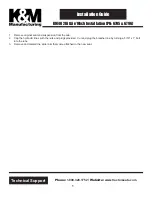
INTRODUCTION
CONTAMINANTS
General
No mobile air conditioning system can operate for long without picking up some contaminants in the refrigerant. The
flexible hoses, for example, allow moisture and air to migrate into the refrigerant from the outside atmosphere. Mois-
ture and non-condensable gases (air) are the most common contaminants found in mobile air conditioning systems.
NOTICE:
Contaminating
R134
A
with R12 or CFC will lead to copper plating of steel components and major compres-
sor failure.
Lubricant and refrigerant that remain in service equipment can be contaminants. When you recover a refrigerant, you
also will capture a certain amount of lubricant in the extraction or recovery equipment. The equipment will drain the
lubricant in a catch bottle or reservoir for measurement and proper final disposal.
Never use a lubricant that has come out of an air conditioning system. Reusing this oil will result in contamination of
the air conditioning system with refrigerant, moisture and air from the old oil. Instead, refill the air conditioning system
using fresh oil in the same amount as that removed during service. Dispose of the used oils in a manner that complies
with federal, state and local disposal requirements.
To avoid contamination between systems using dissimilar refrigerants, the extraction and recycling equipment MUST
be dedicated to a single refrigerant.
Preventing Mixing of Service Equipment
To help avoid the mistake of charging a system with an incorrect, incompatible refrigerant, the compressor fittings are
different for refrigerants R12 and
R134
A
. Systems using
R134
A
have quick couple service connections, while R12
systems use screw threads. This prevents the use of the same tools for different refrigerants, thereby helping to avoid
the mixing of refrigerants in service equipment.
If refrigerants become mixed, the thermodynamic and chemical characteristics will change. This change results in
excessive pressure and poor lubrication and leads to failure of the compressor, desiccant (drier) and other system
components.
Ultimately, system failure and an expensive repair bill will result if refrigerants become mixed in a single set of service
equipment.
REFRIGERANT EXTRACTION AND RECYCLING EQUIPMENT
Both extraction and recycling equipment are in use and available to service technicians. Both types of equipment
will remove the refrigerant from an air conditioning system. However, extraction equipment only pulls the refrigerant
from the air conditioning system and stores it in an appropriate container. Extraction equipment does not clean the
refrigerant. Its only purpose is to recover the refrigerant from an air conditioning system prior to disassembling and
servicing it.
Always recycle or reclaim recovered refrigerant before putting it back into an air conditioning system. During service
operations involving a partial recharge, or while the air conditioning system is in use, refrigerant can pick up moisture,
lubricants, microscopic metal chips, and other potential contaminants. In many cases the contaminants contribute to
or are the primary cause of the system failure. Putting used, unclean refrigerant back into an air conditioning system
may result in poor system performance.
NOTICE:
Reuse of unrecycled, unreclaimed refrigerant will void the warranty.
Equipment that removes refrigerant from a mobile air conditioning system (recovery equipment) may allow you to put
the used refrigerant back in the system without first cleaning it to minimize performance. You may also use such con-
ditioning systems. Non-mobile air conditioning systems use refrigerants and contain contaminants that are different
from those in mobile air conditioning systems. Recovery equipment may therefore allow the mixing of different types
of refrigerants or introduce contaminants that may not be removable by recycling equipment available in the service
shop.
If you want to remove, clean and reuse
R134
A
refrigerant, you must use a machine that both extracts and recycles
refrigerant from mobile air conditioning systems. Dedicate that machine to R134a only.
47941906 16/03/2016
7
Summary of Contents for FARMALL 40C
Page 8: ...INTRODUCTION 47941906 16 03 2016 1 Find manuals at https best manuals com...
Page 12: ...INTRODUCTION Safety rules Farmall 40C NA Farmall 50C NA BT09A213 1 47941906 16 03 2016 5...
Page 51: ...This as a preview PDF file from best manuals com Download full PDF manual at best manuals com...





































